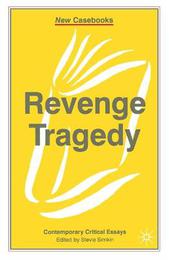
|
Revenge Tragedy
Hardback
Main Details
| Title |
Revenge Tragedy
|
| Authors and Contributors |
By (author) Stevie Simkin
|
| Series | New Casebooks |
|---|
| Physical Properties |
| Format:Hardback | | Pages:268 | | Dimensions(mm): Height 216,Width 140 |
|
| Category/Genre | Literary studies - c 1500 to c 1800
Literary studies - plays and playwrights |
|---|
| ISBN/Barcode |
9780333922378
|
| Classifications | Dewey:822.309 |
|---|
| Audience | | Further/Higher Education | | Undergraduate | |
|---|
| Illustrations |
IX, 268 p.
|
|
Publishing Details |
| Publisher |
Bloomsbury Publishing PLC
|
| Imprint |
Red Globe Press
|
| Publication Date |
12 June 2001 |
| Publication Country |
United Kingdom
|
Description
In this volume Stevie Simkin has collected essays on five plays which are representative of the genre of revenge tragedy: "The Spanish Tragedy", "The Revenger's Tragedy", "The Changeling", "The White Devil" and "'Tis Pity She's A Whore". These plays are a rich source of ideas about Renaissance society and politics recurrent issues include sexuality, the complex relations of gender and power, and the relationship between the individual and the state. The collection as a whole demonstrates a variety of critical approaches to the genre, including feminist, psychoanalytic, new historicist and cultural materialist viewpoints, inspiring students to revisit these plays and to engage directly with the politics of past and present, and the ways in which they interrelate.
Author Biography
STEVIE SIMKIN is Senior Lecturer in Drama in the School of Community and Performing Arts at King Alfred's College, WInchester.
Reviews'The collection is a great asset not only to the examination of the revenge tragedy genre but also to the exploration of late twentieth century critical approaches such as poststructuralism, feminism, post-colonialism, new historicism, cultural materialism, and performance theory...Simkin's hand as an editor is present in helpful and instructive ways in this collection. The introduction is informative and straightforward. But more importantly, his notes at the end of each essay are pithy and thorough. He situates the articles within larger theoretical and methodological discussions, often highlighting any innovative elements within the argument. These summaries will be invaluable for students delving into contemporary criticism for the first time.' - Ayanna Thompson, University of New Mexico, Early Modern Literary Studies
|